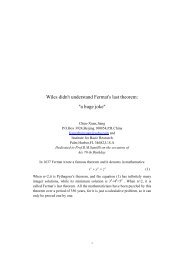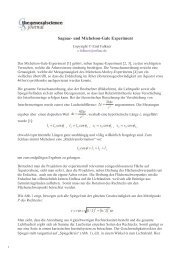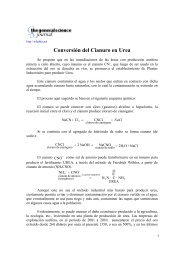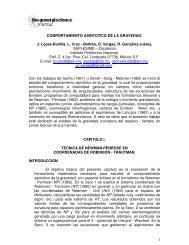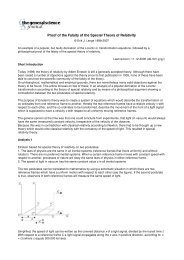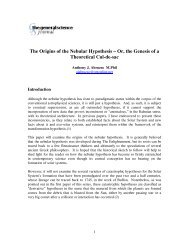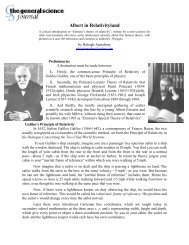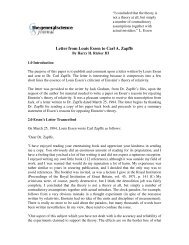MAGNETISM DURING THE SEVENTEENTH CENTURY HH Ricker III
MAGNETISM DURING THE SEVENTEENTH CENTURY HH Ricker III
MAGNETISM DURING THE SEVENTEENTH CENTURY HH Ricker III
Create successful ePaper yourself
Turn your PDF publications into a flip-book with our unique Google optimized e-Paper software.
destroy the power of a lodestone. One was to place it near another more powerful stone, which<br />
could<br />
“...in a short time enchange its Poles; or being kept in undue position, that is, not lying on the<br />
meridian or else with its poles inverted, it receives in longer time impair in activity.”<br />
Browne’s chapter continues with a discussion of errors in magnetic history, medicine and magic.<br />
He ends with a brief mention of the fundamental ideas of Gilbert’s magnetical philosophy that<br />
motions of celestial bodies are due to magnetism. “Many other magnetisms may be pretended<br />
and the like attractions through all the creatures of nature. Whether the same be verified in the<br />
action of the Sun upon inferior bodies... whether the flux and reflux of the Sea be caused by any<br />
Magnetism from the moon...might afford a large dispute”. Hence for Browne, Gilbert’s magnetic<br />
philosophy remained merely an interesting unproved hypothesis. Browne also ignored many<br />
other of Gilbert’s discoveries. Most significant is his complete failure to mention the experiments<br />
which form the basis of Gilbert’s rudimentary field theory, and in particular Gilbert’s concept of<br />
the orb of virtue. Apparently, the field theory concept was beyond the grasp of even the very best<br />
educated English savants of the seventeenth century.<br />
Galileo’s Researches in Magnetism<br />
In continental Europe, Gilbert’s work was received with more enthusiasm. Kepler attempted to<br />
incorporate it into his theory of the solar system. Galileo admired the experimental aspects and<br />
performed his own researches. Vincenzio Viviani who liked to style himself as “the last disciple<br />
of Galileo” describes some of Galileo’s magnetic experiments:<br />
”towards the end of 1604 he had completed a long study of the properties of the<br />
loadstones, and after many and varied experiments had found a sure way of arming any given<br />
stone so as to make it sustain a weight of iron 80 to 100 times greater than could be supported by<br />
the stone unarmed-a result which had not been reached by any investigator up to that time”. 6<br />
It is believed that Galileo may have been performing experiments in magnetism prior to the<br />
publication of On the Magnet. Professor Favaro of Padua, a biographer of Galileo, tells us that:<br />
”our philosopher had been engaged on these studies for a considerable time, if not to a<br />
date anterior to the issue of Gilbert’s book, certainly very soon after, when he verified all the<br />
experiments of the English philosopher and instituted new ones of his own.” 6<br />
It is certain that publication of Gilbert’s book stimulated him to active research in magnetism,<br />
because we have letters written in the immediately following years which describe Galileo’s<br />
experiment with loadstones. These experiments resulted in one sure demonstration of a repulsive<br />
effect of magnetism, known as superposed magnetism. This is described in a letter written in<br />
1608.<br />
“I have also observed in this stone another admirable effect which I have not met with in<br />
any other, namely, that the same pole repels or attracts the same piece of iron according to<br />
distance. Thus, placing an iron ball on a smooth and level table, and quickly presenting the stone<br />
at about a one finger’s distance, the ball moves away and can be chased about at pleasure. But



